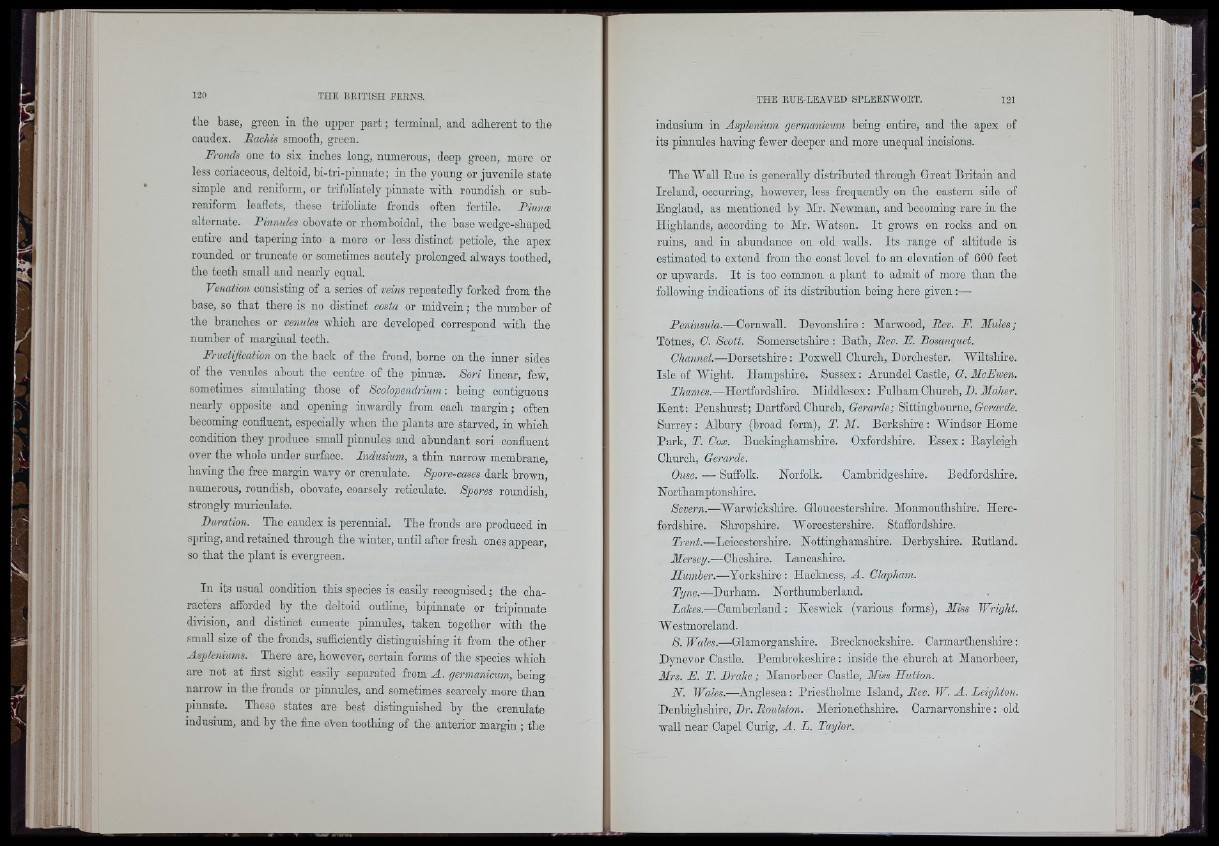
:ri I
the base, green in tbe upper part ; terminal, and adherent to the
caudex. Rachis smooth, green.
R'onds one to six inches long, numerous, deep green, moro or
less coriaceous, deltoid, bi-tri-pinnate; in the young or juvenile state
simple and reniform, or trifoliatcly pinnate with roundish or sub-
reniform leaflets, those trifoliate fronds often fertile. Pinnæ
alternate. Pinnules obovate or rhomhoidal, the base wedge-shaped
entii-e and tapering into a more or less distinct petiole, the apex
rounded or truncate or sometimes acutely prolonged always toothed,
the teeth smaU and nearly equal.
Venation consisting of a series of veins repeatedly forked from the
base, so that there is no distinct costa or midvein ; tho number of
the branches or venules which are developed correspond with the
number of marginal teeth.
Fructification on the back of the frond, borne on the inner sides
of the venules about the centre of the pinuæ. Sori linear, few,
sometimes simulating those of Scolopendrium : being contiguous
nearly opposite and opening inwardly from each margin ; often
hecoming confluent, especially when the plants are starved, in which
condition they produce small pinnules and abundant sori confluent
over the whole under srnfface. Indusium, a thin narrow membrane,
having the free margin wavy or crenulate. Spore-cases dark brown,
numerous, roundish, obovate, coarsely reticulate. Spores roundish,
strongly mnriculate.
Buration. The caudex is perennial. The fronds are produced in
spring, and retained through the winter, until after fresh ones appear,
so that the plant is evergreen.
In its usual condition this species is easily recognised ; the characters
afforded by the deltoid outline, bipinnate or tripinnate
division, and distinct cuneate pinnules, taken together with the
small size of the fronds, sufficiently distinguishing it from the other
Aspleniums. There are, however, certain forms of the species which
are not at first sight easily separated from A. germanicum, being
narrow in the fronds or pinnules, and sometimes soaroely more than
pinnate. These states are best distinguished by the crenulate
indusium, and by the fine eVen toothing of the anterior margin ; the
indusium in Asplenium germanicum being entire, and the apex of
its pinnules having fewer deeper and more unequal incisions.
The Wall Rue is generally distributed through Great Britain and
Ireland, occurring, however, loss frequently on the eastern side of
England, as mentioned by Mr. Newman, and beooming rare in the
Highlands, according to Mr. Watson. It grows on rooks and on
ruins, and in abundance on old walls. Its range of altitude is
estimated to extend from the coast level to an elevation of 600 feet
or upwards. It is too common a plant to admit of more than the
following indications of its distribution being here given:—
Peninsula.—Cornwall. Devonshire : Marwood, Rev. F. Mules;
Totnes, G. Scott. Somersetshire : Bath, Rev. F. Bosanquet.
Channel.—Dorsetshire: Poxwell Church, Dorchester. Wiltshire.
Isle of Wight. Hampshire. Sussex: Arundel Castle, O. McFwen.
Thames.—Hertfordshire. Middlesex: Fulham Church, D. Maher.
Kent: Penshurst; Dartford Church, Oerarde; Sittingbourne,
Surrey: Albury (broad form), T. M. Berkshire : Windsor Home
Park, T. Cox. Buckinghamshire. Oxfordshire. Essex: Rayleigh
Church, Gerarde.
Ouse. — Suffolk. Norfolk. Cambridgeshire. Bedfordshire.
Northamptonshire.
Severn.—Warwickshire. Gloucestershire. Monmouthshire. Herefordshire.
Shropshire. Worcestershire. Staffordshire.
Trent.—Leicestershire. Nottinghamshire. Derbyshire. Rutland.
Mersey.—Cheshire. Lancashire.
Ilumher.—^Torkshire : Hackness, A. Clapham.
Tyne.—Durham. Northumberland.
Lakes.—Cumberland: Keswick (various forms). Miss Wright.
Westmoreland.
8. Wales.—Glamorganshire. Brecknockshire. Carmarthenshire:
Dynevor Castle. Pembrokeshire : inside the church at Manorbcer,
Mrs. E. T. Brake; Manorheer Castle, Miss Hutton.
N. Wales.—Anglesea: Piiestholme Island, Rev. W. A. Leighton.
Denbighshire, Br. Roulston. Merionethshire. Carnarvonshire : old
wall near Capel Curig, A. L. Taylor.
I|
, ii, [I
, r il
' ..
■’"ri
-.i”'
I ' 'J
? i J
, N f
p
ri !
I f ]
i ]' [ e-
; 1
i l l
■ 1
r
■ 1
11^
ri